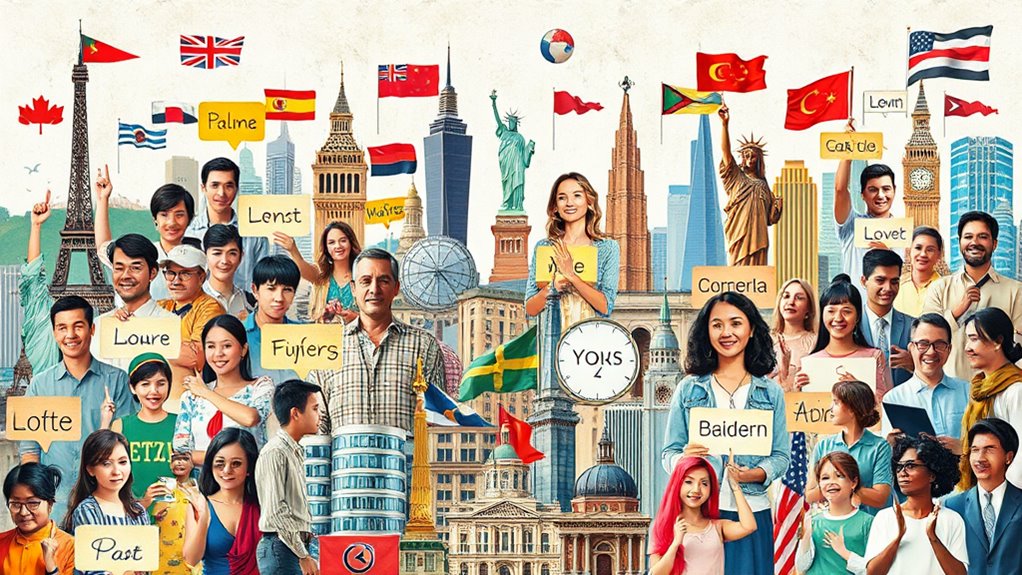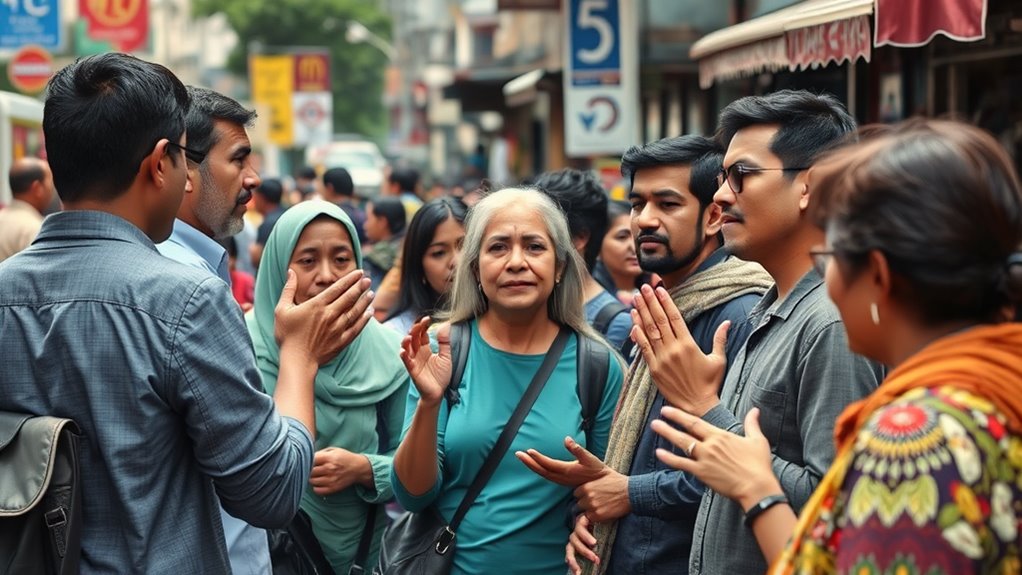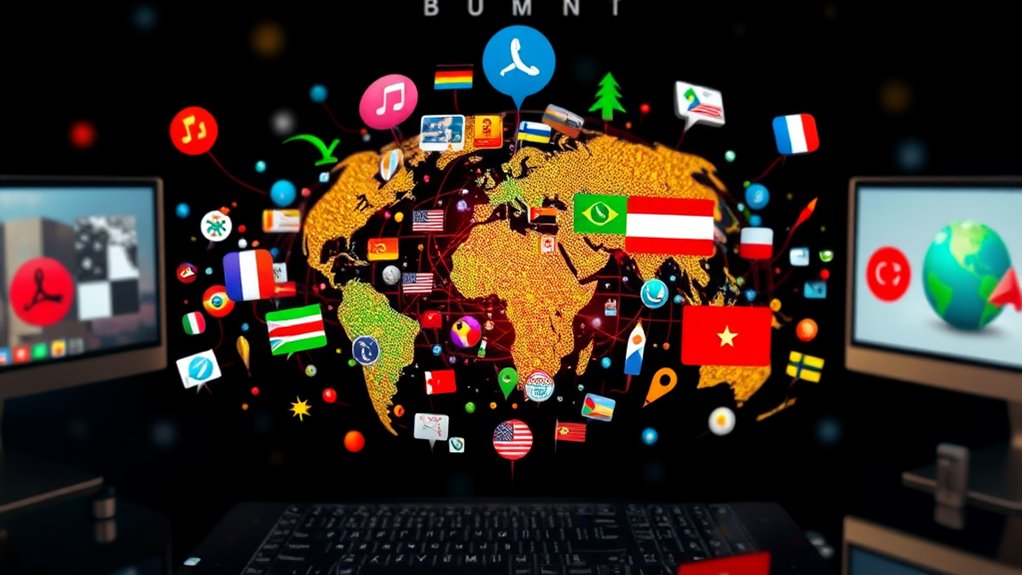The world probably won't ever speak just one language. While English dominates global communication, over 6,500 languages still exist, and many are endangered or dying out. Globalization fosters shared languages but also reinforces local tongues' importance. Younger generations tend to adopt dominant languages for job opportunities, which pressures cultural identities tied to unique languages. Language loss means losing distinctive worldviews and cultural practices. Consequently, while some languages may rise in influence, it's unlikely we'll see widespread adoption of a single global language. You might be surprised to discover how essential language preservation is to our shared heritage.
Essential Insights
- Globalization promotes dominant languages like English, but cultural and linguistic diversity remains essential for identity and expression.
- Over 6,500 languages exist today, indicating a strong preference for linguistic variety across different cultures.
- Language loss is accelerating, with 40% of languages at risk of extinction, making a single global language unlikely.
- Hybrid languages, such as Spanglish, emerge from bilingual communities but highlight the coexistence of multiple languages rather than a singular one.
- Efforts for language preservation and revitalization emphasize the importance of maintaining linguistic diversity rather than converging to one language.
Current Language Landscape

As the world becomes more interconnected, the current language landscape reveals a rich tapestry of linguistic diversity. With over 6,500 languages spoken globally, it's clear that language preservation is vital in maintaining this diversity. Unfortunately, 634 known languages have already become extinct, and many more are at risk. You might be surprised to learn that 335 languages have fewer than 10 speakers, pushing them toward extinction. This alarming trend highlights the significance of multilingual education, which can foster appreciation and understanding of various languages.
In regions like the US, where 22% of residents speak a language other than English at home, the push for multilingual education is essential. This growing demographic reflects broader global trends, as linguistic diversity increases. By incorporating language preservation efforts into educational systems, schools can equip students with the skills to communicate in multiple languages, thereby promoting cultural heritage. Additionally, it's notable that the top 10 languages account for 50% of the global population, emphasizing the need for multilingualism in education.
You may also notice that while languages like Mandarin and Spanish boast millions of speakers, the online presence of languages varies greatly. For instance, English dominates with over 52.1% of online content, while Arabic accounts for only 0.6%. This disparity calls for enhanced language access initiatives, ensuring that speakers of all languages have equitable opportunities for representation.
Fostering multilingual education and prioritizing language preservation can empower communities, enrich societies, and help maintain the world's linguistic diversity, ultimately contributing to a more inclusive global conversation.
The Rise of English

Over 1.35 billion people around the world speak English, making it the most prevalent language today. This staggering number highlights English dominance in global communication, shaping how you interact in business, education, and beyond. As you explore different cultures, English serves not only as a means of communication but also as a bridge for cultural exchange.
In many countries, English is the primary language taught in schools. For instance, 96% of students in Continental Europe learn English, which illustrates its role as a global educational tool. As you can see in the table below, the economic impact of English is profound, supporting millions of jobs and generating significant income. Furthermore, the global English language learning market is projected to reach $69.62 billion by 2029.
| Aspect | Impact |
|---|---|
| ELT Sector Income | £1.4 billion annually |
| Jobs Supported | 35,700 |
| Average Stay (students) | 3 times longer than visitors |
| Global Learning Market | $69.62 billion by 2029 |
| English Speakers in Europe | 200 million |
As you consider your place in this global landscape, it's clear that English is more than just a language; it's a tool for connection. By embracing its use, you participate in a rich tapestry of cultural exchange, where ideas and values cross borders. The rise of English is reshaping our world, making it essential for you to engage with this evolving language.
Globalization's Language Influence

Globalization has transformed the way languages spread and evolve, impacting how we communicate across cultures. With increased mobility, you've likely noticed how language migration has accelerated, allowing languages to diffuse into new regions. For instance, Mandarin Chinese has gained prominence worldwide through initiatives like Confucius Institutes, showcasing how cultural exchanges promote language growth.
As people move across borders, we see the emergence of hybrid languages. A prime example is Spanglish, a blend of Spanish and English, which reflects the unique experiences of bilingual communities. Such linguistic adaptations arise from the need for effective cross-cultural communication, especially in diverse environments. Additionally, the rise of new hybrid languages reflects the interconnectedness of global communities, further enriching the linguistic landscape.
However, globalization has also led to the dominance of a few languages, such as English and Spanish, overshadowing local tongues. This linguistic imperialism threatens to erase many minority languages, with estimates suggesting that around 40% of the world's 7,000 languages could become extinct. As dominant languages take precedence, regional dialects are also evolving—think of the differences between American and British English.
While these trends pose challenges to language diversity, there's hope. Many communities are reviving their native languages, emphasizing multilingual education to preserve their linguistic heritage.
Technology's Role in Language

The evolution of language in today's world isn't just shaped by cultural exchanges; technology plays a significant role in how we document, preserve, and revitalize languages. Digital documentation tools make it easier for you to access and store language data, aiding in cultural preservation efforts.
Mobile apps and cloud computing enhance this accessibility, allowing communities to engage in language revitalization like never before. You'll find that interactive tools, such as augmented reality (AR) and virtual reality (VR), create immersive experiences that engage users actively in learning endangered languages.
Social media platforms broaden the reach of language resources, connecting speakers and learners globally. Language learning apps can be tailored to support these endangered languages, making learning more personalized and effective. In this context, technology integration is recognized as crucial for documentation and revitalization.
However, technological barriers still exist. Digital literacy remains a significant challenge, limiting the effectiveness of these tools in some communities. In addition, access to technology and reliable internet can hinder progress.
Community engagement is essential; guaranteeing that documentation efforts are culturally relevant helps avoid misrepresentation and fosters a sense of ownership. As you explore the role of technology in language, it's clear that while it offers powerful tools for documentation and revitalization, it must be approached thoughtfully.
Balancing modern methods with traditional learning guarantees that the essence of each language is preserved. With ongoing research and community empowerment, technology can indeed play a transformative role in sustaining linguistic diversity.
The Threat of Language Extinction

A staggering number of languages face the threat of extinction, with pressures from dominant languages like English and Spanish pushing smaller tongues to the brink. You mightn't realize it, but around 634 languages have already become extinct, and 335 of them have fewer than 10 speakers left. This rapid decline stems from forced assimilation, cultural shifts, and government policies favoring major languages in education and media. Approximately 3,054 languages are currently endangered, highlighting the urgent need for intervention.
As globalization intertwines cultures, younger generations often prioritize learning dominant languages for better job prospects and social mobility. This shift not only diminishes linguistic diversity but also erodes cultural identity. When a language disappears, it takes with it unique ways of thinking and expressing human experience.
Language preservation efforts are indispensable to combat this trend. Documenting endangered languages through written, audio, and video formats helps create essential resources for future generations. Revitalization programs and community engagement initiatives encourage the use of these languages in daily life, fostering a sense of pride and connection to cultural heritage.
Advocacy plays a critical role as well, raising awareness about the importance of protecting linguistic diversity. Organizations like UNESCO work tirelessly to support endangered languages, reminding us that every language lost is a loss for humanity.
If we don't act now, the world could become a place where fewer voices are heard, and cultural identities fade into obscurity. The time to act is now.
Frequently Asked Questions
What Are the Cultural Implications of a Single Global Language?
A single global language can lead to cultural homogenization, threatening linguistic diversity.
You might find that unique traditions and local identities fade as global communication prioritizes one language over others. While it facilitates interaction, this shift risks cultural preservation, as regional dialects and practices diminish.
Embracing multiple languages fosters richer exchanges and deeper understanding, allowing you to celebrate and maintain your cultural heritage amidst the tide of globalization.
How Do Bilingual Individuals Navigate Multiple Languages in Daily Life?
Maneuvering multiple languages daily, you practice language switching, enhancing your cognitive advantages.
This flexibility helps you break down communication barriers, allowing richer interactions in diverse social dynamics.
Bilingual education fosters cultural adaptability, letting you express your identity more fully.
While you appreciate the benefits, you also value language preservation, ensuring that your heritage remains intact.
Balancing these aspects enriches your experience, making you more aware of the world's linguistic richness.
What Role Does Language Play in Personal Identity and Heritage?
Language is like a magical key, opening doors to your identity and heritage.
It's not just about words; it's about language preservation and cultural expression that shape who you are. As you weave your personal connections through stories and songs, you experience identity formation and heritage transmission.
Embracing linguistic diversity enriches your life, helping you celebrate your roots while connecting with others.
Can Artificial Intelligence Create a Truly Universal Language?
You might wonder if AI can truly create a universal language. While AI translation technologies like Google's GNMT show promise in language evolution, they focus on specific tasks rather than human communication.
Creating a universally accepted language faces challenges due to cultural nuances and linguistic diversity. AI can assist in bridging gaps, but it's unlikely to generate a language that resonates with everyone's identity or heritage.
The future might hold advancements, but a universal language remains elusive.
How Do Regional Dialects Affect the Concept of a Single Language?
Regional dialects greatly influence the idea of a single language, as they showcase dialect evolution and linguistic diversity.
You might notice that even neighboring areas develop unique speech patterns over time. These differences highlight how language adapts to cultural and geographical factors.
As you encounter various dialects, you'll see that they enrich communication but also complicate the possibility of a unified language.
Ultimately, these variations reflect the complexity of human expression.
